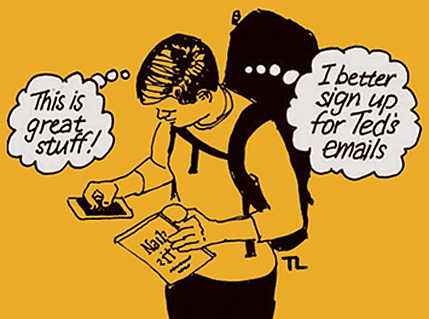Uh-oh…I ran out of clients!

Many of us fail to act in time to avert impending disasters — especially the ones that don’t hit all at once. If you’re a freelancer or small business owner, arguably the biggest crisis you can possibly face is watching your client base dwindle. But that sometimes happens too slowly to sound the alarms early enough. Even when revenue starts to dry up, it often peters out slowly, and we comfort ourselves with the thought that we’ve got a few other irons in the fire, so we’ll be back on track any day now.
Many of the people I coach have come to me when they’re already deep into this type of disaster but have just come around to realizing it. In most cases, the obstacles to taking quick, decisive action are the same.
Fear Blooms Slowly
“My work has just plain dried up,” my coaching client Carson admitted, holding his head in his hands. “All my clients have either gone in-house or are using giant agencies. If it’s not that, they bring on new executives with their own ways and end my contract.”
It confirms our fears that we’re no good and our work isn’t relevant. And for a while, denial insulates us from these anxieties.
It’s pretty normal for work to ebb and flow, especially if you work for yourself. That’s just something independent workers need to get comfortable with. The problem is when they get too comfortable. Carson had been thinking he could wait out the latest down-cycle, but now his growing family was relying primarily on his wife’s income, and they were getting scared.
That fear can creep up on you, and it can be paralyzing. I used to think my coaching clients just needed a few tips on where or how to search for new business — or that they maybe just needed a confidence boost before taking action. But I’ve found that my prescriptions only worked briefly. Eventually it became clearer that a deeper-seated emotion was at play, and it needed rooting out.
It’s not revolutionary to point out that fear can be crippling, but this really hit home for me when Carson showed me the garden he’d been creating in his backyard. What a fabulous monument to fear and its partner, denial! Gardening was distracting Carson from tending the garden of his business.
Denial and procrastination are understandable short-term reactions to the unpleasant reality of fear, especially when it unfolds over time in response to crises that do the same. We begin to feel vulnerable when sales are down and new business just isn’t coming in. We take it personally. It confirms our fears that we’re no good and our work isn’t relevant. And for a while, denial insulates us from these anxieties.
Rejection is always a possibility when soliciting new business. It’s painful. Denying there’s a problem protects us from that pain.
Workflow as Refuge
Unfortunately, denial isn’t the only counterproductive habit people fall into when their work starts to dry up. Carson had lost himself in the joy of building a garden. Unable to attract enough new work for his business, he simply immersed himself in something else.
I’ve also seen people in the midst of financial crisis find refuge in planning how to get out of said crisis.
I understand this feeling. Many people who work for themselves or run their own firms are passionate about what they do, so we lose ourselves in the flow of our work. I lose myself in the process of writing. This kind of flow, in fact, may even be one reason many people become their own bosses in the first place — in the hope of shunting aside organizational constraints and office politics so they can wrap themselves in the comfort of actually doing the work.
Believe it or not, I’ve also seen people in the midst of financial crisis find refuge in planning how to get out of said crisis. This may sound like a good thing, but it rarely is. The very process of planning a remedy is a way of avoiding action. Drawing up a plan can provide the same kind of comforting feeling that any creative endeavor does. Yet if the plan isn’t actually generating results, and sales continue to lag, it’s time to scrap it and do something different.
Breaking the Shame Cycle
The reason so many people let denial take over and hide in the comfort of work isn’t hard to understand: shame. On some level, we know we’re entering a crisis and feel helpless to fend it off, which leaves us feeling ashamed. It’s a vicious cycle: We see our repeated, active denial, and the charades of activity we hide behind, and we feel more shame. Unacknowledged, that shame can lock us into self-recrimination and inaction.
What moves us to wake up and act? For me, sometimes just recognizing the presence of shame provides the necessary first jolt. I’ve also found a third-party perspective to be critically helpful — to have someone who’s not emotionally involved in my own anxieties and can point out what’s happening.
The first step to getting back on track is recognizing the problem for all its potential danger. Acknowledge your fear and your avoidance. Examine the crisis, and detail its particulars. This new awareness could unleash a fresh flood of shame, but don’t let that overwhelm you.
Next, talk about the problem with a coach or colleague who understands your business but isn’t emotionally involved. Only then can you lay out a plan that leads to real action (as opposed to just planning as a form of procrastination). Try these three steps:
- Make a list of your past and current clients.
- Determine precisely how you could help three of them in a concrete way you haven’t already — whether or not that is/was part of the work for which they originally contracted with you. Then phrase that in two sentences: “I can help client X with Y by doing Z.”
- Then pick up the phone and make three calls. Don’t wait, don’t draft a four-paragraph email — just call.
I’ve found that taking action like this tends to reduce fear and cut away the diversions that get in the way of actually acquiring more work. When your client base dwindles slowly, there’s often no real sense of urgency. At a minimum, this approach can help you recover it — so you can start getting your business back, too.
This post originally appeared in Fast Company.





